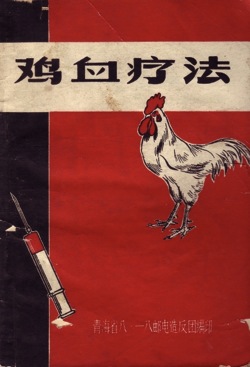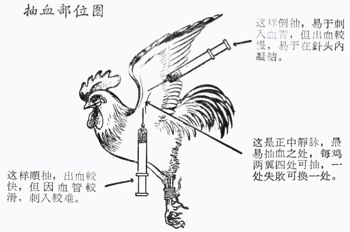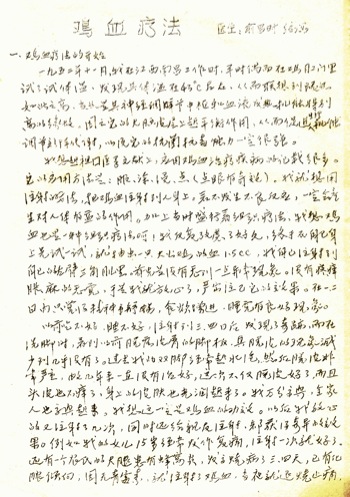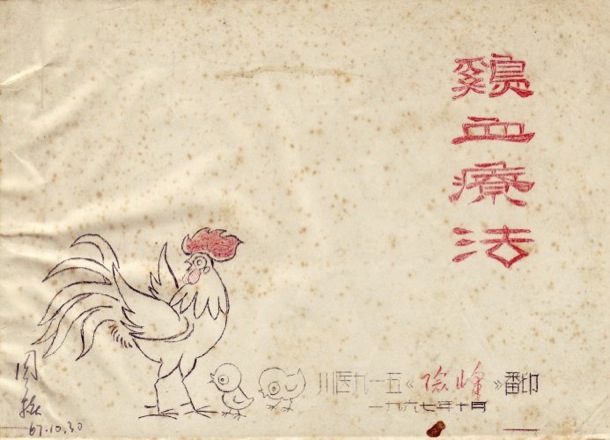|
ARTICLES
Injecting Chicken Blood | China Heritage Quarterly
Injecting Chicken Blood
Joel Martinsen
Danwei Media, Beijing
The fad for chicken blood injects swept China over a number of years. Yang Xianyi was among many who treated it, along with the various manias common in the Mao and post-Mao years, with healthy derision, as indeed did the writer Sang Ye, a friend of Xianyi and Gladys. The Beijing-based writer, and co-editor of Danwei, Joel Martinsen traced the peculiar history of chicken blood in the People's Republic and published the following article on 13 October 2010. It is reprinted here with minor emendations by the author with the kind permission of Danwei.—The Editor

Fig.1 A manual edited and printed by the 8-18 Postal & Telecom Rebel Corps of Qinghai province.
This has not been a good year for health gurus. Zhang Wuben 张悟本, a nutrition advisor whose TV spots and bestselling books pushed raw vegetables as the cure for a host of serious medical conditions, was busted for faking his credentials and charging immense sums for brief consults. More recently, the media turned its eye on Li Yi 李一, a Daoist master who offered high-priced services to China's rich and famous and claimed extraordinary physical powers including the ability to cure cancer. And in the fall, urologist Xiao Chuanguo 肖传国 was sentenced to five-and-a-half months in prison for ordering the beating of two science writers who had accused him of fabricating test results to inflate the success rate of a procedure he developed.
In an article written in the early 1990s, essayist Sang Ye 桑晔 expressed the hope that the Chinese public would no longer be held in the grip of pseudoscientific, quack cure-alls: 'This is the information age, and no one can stay on top for five hundred years, or perhaps even five hundred days.' Yet less than a decade later, self-made doctor Hu Wanlin 胡万林 was able to kill scores of people over the course of several years by prescribing qigong treatments and poisonous herbal concoctions for all sorts of maladies. Before his arrest and imprisonment, Hu had been the subject of fawning reports in the press and a hagiography authored by a bestselling novelist.[1]
Sang Ye's essay, published in the April, 1992 issue of the literary journal Reading (Dushu 读书) under the title 'Have the Chinese People Really Awakened from Their Dream-state?' (Guoren meng yi xing? 国人梦已醒?) was prompted by the popularity of several books promoting the paranormal abilities of purported psychic masters: one claimed psychokinetic powers that would enable him to obtain Soviet and American nuclear weapons through teleportation; another detailed the process by which she acquired fluency in the information language of the universe, allowing her to speak with aliens; a third book came with an accompanying cassette tape into which a master had infused his power, to be released during playback. He then presented a short rundown of some of the previous health fads that had swept the country during his lifetime:
One was kombucha (hongcha jun 红茶菌), a kind of algae, or perhaps a kind of mollusk, soaked in water.[2] It was said that eating or drinking it would prolong life, turning everyone into the God of Longevity, able to witness the paradise of the future. Another was known as 'drinking cold water' (he liangshui 喝凉水): two ounces of cold water taken in the early morning were useful for something I've now forgotten, probably preventing or curing illness. Third was 'injecting chicken blood' (da jixie 打鸡血): people carried young roosters to the hospital, where several milliliters of chicken blood would be drawn and then injected into their body. Doing this once a week would make you aggressive, and as powerful as an ox. Fourth was 'arm swinging' (shuaishou 甩手). Getting up at five in the morning to stand on the roadside breathing in the dust and exhaust while swinging your arms for an hour was said to eradicate everything from the common cold to cancer. Fifth was something akin to that that 'external alchemy',[3] although it was known as 'post-standing' (zhan zhuang 站桩), but it too had a burst of popularity. The explanation given was rather different from the workings of external alchemy: it was highly aggressive, with examples like how an eighty-year-old woman could train to be able to stun punks and so forth. Once these had passed, people began experimenting with whether they could 'hear' printed characters or go three days without eating, and then they discovered that there were indeed people who could 'pass a car' or who were 'impenetrable to the blade'. Others who were privy to the files of Chinese and American intelligence agencies could not explain why American files, like their Chinese counterparts, consisted of cabinet after cabinet of paper instead of magnetic computer disks. And once all of that had passed, today's masters now enjoy their time on top.[4]

Fig.2 How to draw blood from a rooster: 'This, the central vein, is the easiest spot for drawing blood. Two wings on each bird give four locations to swap in case of failure.' The top needle: 'This will draw against the flow. Piercing the blood vessel is easy, but flow is slow and can clot inside the needle.' Bottom needle: 'This will draw with the flow. Blood will flow quickly, but because the vessel is slippery, penetration is difficult.'
Many of these practices have stuck around in one form or another. Kombucha is still promoted as a health supplement in many parts of the world, exercise fads come and go every few years, and drinking water is always recommended (though not as a cure for cancer). Chicken blood, on the other hand, is a relic of a different age. These folk remedies flourished at a time when trained doctors and effective medicine were scarce, and the notion that a vast array of medical conditions, from abnormal blood pressure to infertility to baldness to leukemia, could be cured with a simple regimen of intramuscular injections of chicken blood was very attractive to people who had few other options, or who harbored suspicions about the class consciousness of the medical establishment.[Fig.1]
'Chicken blood therapy' (jixie liaofa 鸡血疗法), as it was also known, came to prominence during the 1960s. It attracted the attention of health authorities, who investigated the practice, decided it was dangerous, and slapped a ban on its use in 1965. However, the anti-intellectual, anti-elitist climate that seized the country after the Cultural Revolution broke out the following year forced the Ministry of Health to reverse the ban, and the therapy began to be heavily promoted, first in Shanghai and the capital, and then across the country. Below is the preface from a pamphlet prepared in mid-1967 by the 8-18 Post & Telecom Rebel Corps of Qinghai province:
Chicken Blood Therapy: A Fundamental Victory for Fighting the Reactionary Road of the Capitalist Class!
Premier Zhou said: 'The Central Ministry of Health's handling of chicken blood therapy is a violation of Mao Zedong Thought!'
In the eight years since it went into use in May 1959, chicken blood therapy has, by virtue of its singular efficacy, has swiftly spread across the country, to every mountain and rural village, where it has been applauded by the masses of workers, peasants, and soldiers. It will be a great contribution for the call to 'Prepare for war, prepare for famine, for the people!' Due to the reactionary road of the capitalist class taken by the Central Ministry of Health and the Shanghai Health Department, they used 'authoritative experts' and 'foreign conventions' to deal with a new things and put a ban on chicken blood therapy, causing an immense loss to the people's health after eight years!
Once the Cultural Revolution was launched, red guards in the capital and in Shanghai jointly dispatched chicken blood therapy investigation teams to all parts of the country to ascertain the aforementioned situation, and once they returned to Beijing, the central leaders offered their strong support. The 'Ministry of Urban Gentlemen's Health'[5] was compelled to admit its mistake, and on 28 December 1966, it notified the entire country of the cancellation of the mistaken notice banning chicken blood therapy.[Fig.2]
Throughout the next decade, people lined up outside dispensaries, rooster in hand, to receive injections of chicken blood, but once the Cultural Revolution ended, the practice was abandoned along with so much else from that era. When xiangsheng performers Jiang Kun and Li Wenhua satirized the madness over kombucha and chicken blood in the painfully didactic skit 'Don't Be Superstitious' (mo mixin 莫迷信)[6], chicken blood therapy was only a memory, and by the time Sang Ye's article appeared, it had been all but forgotten, kept alive only as a colloquial expression meaning jittery or agitated: 'I'm so excited it's like I've been injected with chicken blood' (我像打了鸡血一样兴奋). The treatment's origin had been lost, if it had known at all during its heyday. A popular rumor, which Sang Ye relates in his article, credited chicken blood injections to a Nationalist official who, facing the execution after the revolution, had attempted to trade the secret in exchange for his life.

Fig.3 Early mimeographed promotional material. This lists 74 curable conditions, vs. 93 in later editions.
Today, two decades further removed from that era, it is actually much easier for ordinary individuals to get their hands on primary source materials. Mimeographed pamphlets and printed promotional booklets, which can be obtained for a few dollars from online used book sellers, describe how chicken blood therapy was invented by one man in the 1950s. Yu Changshi (俞昌时), a doctor from Anhui who had been active in the party during the revolution, paired his observations of roosters with tissue therapies that had been explored in the Soviet Union:
In November 1952, while I was working in Nanfeng, Jiangxi province, I sometimes had occasion to measure the body temperature of chickens through the rectum. I discovered that they were around 43 degrees Celsius, which suggested to me that such a high body temperature was surely a result of the regulating effect of the central nervous system and the high heating function of the blood.... I recalled that the literature of traditional Chinese medicine contained many records of the use of chicken blood to treat illnesses. Methods used were ingestion, smearing, soaking, and dropping (particularly effective in the eyes), so I thought of injection: injecting chicken blood into the human body would not cause any adverse reactions but would certainly be beneficial. In addition, tissue therapy was flourishing at the time, and I thought: chicken blood is another sort of tissue therapy! I considered it for a long time, and finally decided to test it out on my own body. Drawing just 1.5cc of blood from an adult rooster, I performed an injection into my deltoid muscle. At first, I felt nothing special. No pain, no itching, no swelling, no numbness. So I relaxed and closely observed the effects. Over the next day or two, I felt in good spirits, my appetite increased, and my sleep noticeably improved. I hadn't eaten or slept well in the past. And then on the third or fourth day, the miraculous occurred: when washing my feet, the peeling skin I frequently had was practically gone! In the past I would often get blisters on my feet that would then peel severely, and in ten years this had not responded to treatment. Now my peeling feet were better, my scalp no longer itched, and the skin all over my body had gotten smooth. I was ecstatic; my entire family was shocked and overjoyed. I thought that it had to be the work of the chicken blood. Then I had the confidence to inject myself a few more times, and I injected others as well. Everyone saw amazing results.[7]
After Yu moved to Shanghai, the arrival of the Great Leap Forward gave him the opportunity to try out his therapy on workers at a textile mill. District health authorities concluded that the risk of allergic reaction from fresh blood was too great and recommended a hypoallergenic powdered alternative. However, Yu continued his injections privately and promoted the results by mailing out pamphlets containing lengthy lists of successful cases, data about efficacy in treating leukemia and other terminal illnesses, and speculations about possible intravenous use.[Fig.3]
Yu's promotional material was included in booklets printed up and distributed by health groups across the country after the lifting of the Ministry of Health's ban. But public focus was on the chicken blood injections, not on the inventor, and the name of Yu Changshi was forgotten even more quickly than the chicken blood therapy itself.[Fig.4] Myths about the treatment's origins as a high-level state secret may even been fed by Yu's own exaggerated claims of official approval:
A chicken blood therapy research team was set up to do simple animal and clinical tests, all of which were successful. The Ministry of Health, upon review, issued instructions: 'As this method exceeds international standards, it must be kept a secret….' Thus, today it is unknown by ordinary people, and five years have gone by.[8]

Fig.4 Mimeographed manual reprinted by the Sichuan Medical College 915 'Summit' group.
Related material from China Heritage Quarterly:
Notes
[1] Hu's medical theories held that sickness had to be expelled from the body through spitting, vomiting, or diarrhea. The second half of Discovering the Inner Classic of the Yellow Emperor (Faxian Huangdi nei jing 发现黄帝内经, 1997), a 700,000-character work by novelist Ke Yunlu 柯云路, built up Hu's image as a miraculous healer. See Baidu Baike and Wikipedia.
[2] Kombucha, a concoction of tea fermented with yeast and bacteria, originated in Russia and is still consumed in many places in around the world. Kombucha was also known as haibao (海宝, 'jewel of the sea') a name later used for the presumably-unrelated mascot of Shanghai's Expo 2010.
[3] Earlier in the text, Sang Ye distinguishes 'external alchemy' (外丹), a form of Daoist cultivation intended to aid the body and prolong life, from 'internal alchemy' (内丹), techniques designed to transform a mortal into an immortal.
[4] Sang Ye, 'Guoren meng yi xing?', Dushu, 1992:4, p.142. Digital version at Baidu Wenku: http://wenku.baidu.com/view/67b1d5d8d15abe23482f4d34.html.
[5] 城市老爷卫生部: Mao Zedong's 'Directive on Public Health' (对卫生工作的指示), issued on 25 June 1965, used this language to refer to government elites. See Marxists.org.
[6] Although I was unable to locate an online video, the script is currently available at 0633: http://www.0633.cc/a/20061219/5259156843-1.htm
[7] Qinghai sheng ba-yiba youdian zaofan tuan, Jixie liaofa, 1967, p.25.
[8] ibid.
References
Du Xing, Wenge shi 'da jixie' de huangmiu liaofa weihe neng shengxing, Xianfeng guojia lishi, 2009:4. Digital edition at Sina: http://book.sina.com.cn/excerpt/sz/rw/2009-05-26/1052256351.shtml, English edition at Danwei: http://www.danwei.org/health_care_diseases_and_pharmaceuticals/chicken_blood_injections.php .
|